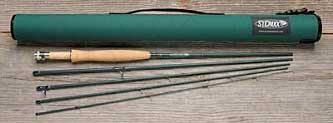Lifetime warranty backed by unmatched St. Croix service. Nothing cheap here. I suppose you could spend more money for components, but as far as durability, the Ultra’s are hard to beat. Call it what you will, but the cork on the Ultra I reviewed is on par with the best I’ve seen in the last five years. If you can truly find a higher grade, I’m not sure it’s worth the increased costs. Years down the road, the Ultra’s components promise to be as serviceable as they are on day one with only reasonable care.

While many graphite rods are built abroad, the Ultra and its older brother, the Elite, are made in the USA, and I don’t mean Usa, Japan. To make it clear and set your mind at ease, these rods are crafted right here in the land of the Stars and Stripes and carry St. Croix’s lifetime warranty. (Sometimes I find it hard to believe that anything is still made in our country.)
 New for this year in both the Ultra and Elite series is a very special 6-weight, 4-piece rod designed for those of us who venture into the salt. With a slender full wells grip, lifting power in the butt, and a requisite fast action, I figured this rod should be the cat’s meow for those of us who head for the flats, especially when the wind is not blowing a gale force. As it happened, this is the rod I was privileged to receive for the purposes of this review. I couldn’t have been more delighted!
New for this year in both the Ultra and Elite series is a very special 6-weight, 4-piece rod designed for those of us who venture into the salt. With a slender full wells grip, lifting power in the butt, and a requisite fast action, I figured this rod should be the cat’s meow for those of us who head for the flats, especially when the wind is not blowing a gale force. As it happened, this is the rod I was privileged to receive for the purposes of this review. I couldn’t have been more delighted!
 So how does it perform? Well, as the Munchkins told Dorothy, “The best place to begin is at the beginning.” When the rod arrived I eagerly tore into the package. Out came the green cordura tube (with handle) containing the rod On the cap, there is a clear description of what’s inside: Line 6, Length 9-feet, Model U906.4.SW. The ID sort of makes it hard to misplace this one. Unsnapping the Alice locking device and lifting the cap, I found the surprise of the year: resting on top of the well-insulated rod is/was a small canister of wax - ferrule wax - complete with directions. The first thing that went through my mind was the old Hallmark Card slogan, “St. Croix cares enough to send the very best.” You see, waxing the male ferrule before the rod is first assembled is important (as are other wax applications two-to-three times a year). The wax lubricates the ferrule and helps minimize the chance for scarring or breakage. While I’ve lectured on this for years, the majority of folks put this off as something to be done “another day.” Making the wax immediately available makes it sort of hard not to wax the ferrule, doesn’t it? Simply said, St. Croix is doing its best to help you become a responsible fly rod owner. These things we call fly rods, as you well know, are not designed to be thrown helter-skelter into the back of a pickem’up.
So how does it perform? Well, as the Munchkins told Dorothy, “The best place to begin is at the beginning.” When the rod arrived I eagerly tore into the package. Out came the green cordura tube (with handle) containing the rod On the cap, there is a clear description of what’s inside: Line 6, Length 9-feet, Model U906.4.SW. The ID sort of makes it hard to misplace this one. Unsnapping the Alice locking device and lifting the cap, I found the surprise of the year: resting on top of the well-insulated rod is/was a small canister of wax - ferrule wax - complete with directions. The first thing that went through my mind was the old Hallmark Card slogan, “St. Croix cares enough to send the very best.” You see, waxing the male ferrule before the rod is first assembled is important (as are other wax applications two-to-three times a year). The wax lubricates the ferrule and helps minimize the chance for scarring or breakage. While I’ve lectured on this for years, the majority of folks put this off as something to be done “another day.” Making the wax immediately available makes it sort of hard not to wax the ferrule, doesn’t it? Simply said, St. Croix is doing its best to help you become a responsible fly rod owner. These things we call fly rods, as you well know, are not designed to be thrown helter-skelter into the back of a pickem’up.
The 6-weight SW features a fighting butt, a hard-anodized aluminum reel seat, and oversized guides. As this picture depicts, the handle and trim fighting butt for the SW 6-weight. I was impressed with the rod as I withdrew it from its case: nice finish, double up-locking reel seat, quality guides, and great cork, as I’ve already mentioned. Everything about the package deserves accolades; in fact, I like the packaging of the Ultra much better than the Elite. The aluminum tube used for the Elite is traditional but certainly not as convenient as the Ultra’s covered Cordura case with handle.

Suffice it to say, the Ultra handles just as good as it looks. The Elite may be a tad faster, but this gun is fast enough to make 90-foot casts to any bone that swims. On the Texas Coast, it’s perfect for specks and redfish in anything short of a gale force wind. However, I would suggest you go for some other rod if your goal is to capture Jaws, The Great White. What rod, I know not -- perhaps if you are very good, a 1-weight would be perfect to whip the 30-foot beast…
With the Ultra, you really get two rods for one: it’s up to either throwing a line a long way or making a gentle and accurate presentation. During the work up for this article, I used several 6-weight lines on the Ultra. I am pleased to say that the rod showed little favoritism among the lines I tried other than for distance. To reach or exceed 90-feet the Ultra, handicapped by my rotten casting stroke, the rod favored (1) a Mastery WF-6-F Bonefish and (2) a Rio WF-6-F WindCutter. So much for the long haul. For the short haul, the Ultra excels in the mid-ranges of from 40 to 70-feet. Expect to make gentle presentations and accurate casts without regard to who made the line (as long as it is a 5 or 6-weight).
Those of you who follow my meandering in and about the gentle art of fly fishing know that I do not favor overlining a rod other than for very short casts inside 30 feet. Thus, no overlining was considered or attempted during my trials with the Ultra; however, I did try underlining and was pleased with the result. The Ultra SW 6 hit 72-feet with a WF-5-F Mastery using little more than a flick of the wrist. Don’t be afraid to try this technique if you decide this rod is for you – it will enable a shorter leader while enhancing a gentle presentation.
Frankly, if you do a little work with the Ultra, even the Ancient Fish Gods may come to fear you – you may become a supreme being when it come to besting Friend Fish. With the Ultra in hand, you are apt to be a wicked weapons system to be favored in mortal battle.
A word about price: St. Croix’s Legend Ultra, despite all of its improvements, holds the line on price. As an example, the 6-weight Saltwater reviewed runs $310.00. In my view, that’s a bargain and a tremendous value for the money asked. It is very hard for me to believe that anyone who throws this rod won’t come to love it. And this is very important. You see, I believe that any rod you come to love is a rod that should forever be kept. Over the years, I have repeatedly been asked about “obsolete” graphite rods. The fact is there is no such thing. Once a rod becomes an extension of your hand, arm, and, more importantly, your mind, it should remain forever as your most trusted friend when you sally forth to battle adversity on the water. You see, rods do not age, only the owner. For you and me, tomorrow’s rod may not be better … just newer…
Try the Legend Ultra … it will be yours for life.
For more information on the St. Croix Legend Ultra or the Legend Elite, contact St. Croix. Telephone 1 (800) 826-7042.